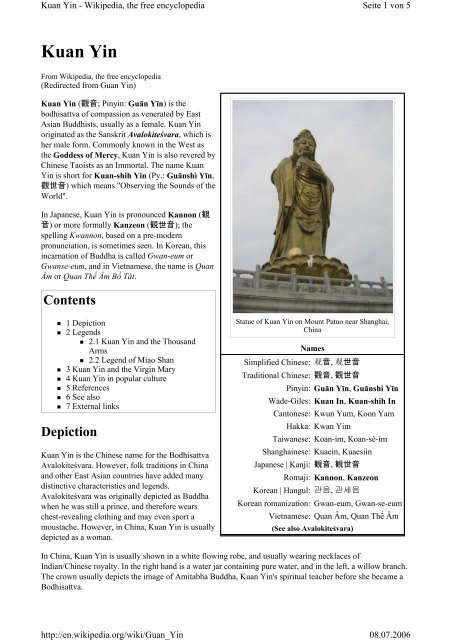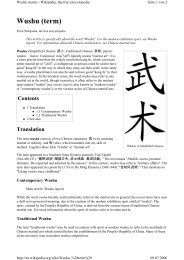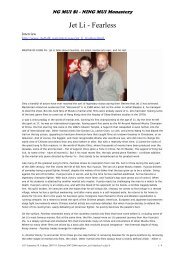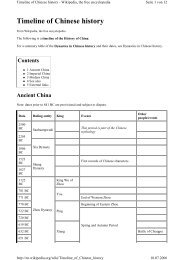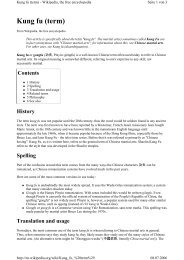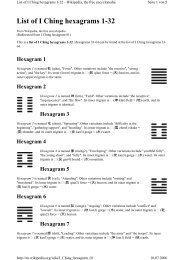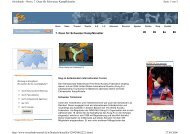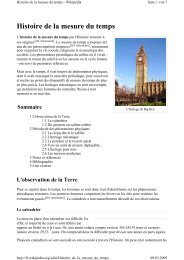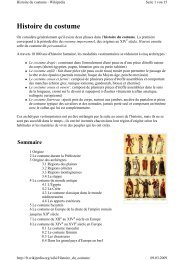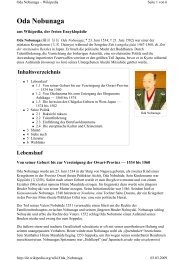You also want an ePaper? Increase the reach of your titles
YUMPU automatically turns print PDFs into web optimized ePapers that Google loves.
<strong>Kuan</strong> <strong>Yin</strong> - Wikipedia, <strong>the</strong> free encyclopedia<br />
<strong>Kuan</strong> <strong>Yin</strong><br />
From Wikipedia, <strong>the</strong> free encyclopedia<br />
(Redirected from Guan <strong>Yin</strong>)<br />
<strong>Kuan</strong> <strong>Yin</strong> (觀音; Pinyin: Guān Yīn) is <strong>the</strong><br />
bodhisattva of compassion as venerated by East<br />
Asian Buddhists, usually as a female. <strong>Kuan</strong> <strong>Yin</strong><br />
originated as <strong>the</strong> Sanskrit Avalokiteśvara, which is<br />
her male form. Commonly known in <strong>the</strong> West as<br />
<strong>the</strong> Goddess of Mercy, <strong>Kuan</strong> <strong>Yin</strong> is also revered by<br />
Chinese Taoists as an Immortal. The name <strong>Kuan</strong><br />
<strong>Yin</strong> is short for <strong>Kuan</strong>-shih <strong>Yin</strong> (Py.: Guānshì Yīn,<br />
觀世音) which means "Observing <strong>the</strong> Sounds of <strong>the</strong><br />
World".<br />
In Japanese, <strong>Kuan</strong> <strong>Yin</strong> is pronounced Kannon (観<br />
音) or more formally Kanzeon (観世音); <strong>the</strong><br />
spelling Kwannon, based on a pre-modern<br />
pronunciation, is sometimes seen. In Korean, this<br />
incarnation of Buddha is called Gwan-eum or<br />
Gwanse-eum, <strong>and</strong> in Vietnamese, <strong>the</strong> name is Quan<br />
Âm or Quan Thế Âm Bồ Tát.<br />
Contents<br />
� 1 Depiction<br />
� 2 Legends<br />
� 2.1 <strong>Kuan</strong> <strong>Yin</strong> <strong>and</strong> <strong>the</strong> Thous<strong>and</strong><br />
Arms<br />
� 2.2 Legend of Miao Shan<br />
� 3 <strong>Kuan</strong> <strong>Yin</strong> <strong>and</strong> <strong>the</strong> <strong>Virgin</strong> <strong>Mary</strong><br />
� 4 <strong>Kuan</strong> <strong>Yin</strong> in popular culture<br />
� 5 References<br />
� 6 See also<br />
� 7 External links<br />
Depiction<br />
<strong>Kuan</strong> <strong>Yin</strong> is <strong>the</strong> Chinese name for <strong>the</strong> Bodhisattva<br />
Avalokiteśvara. However, folk traditions in China<br />
<strong>and</strong> o<strong>the</strong>r East Asian countries have added many<br />
distinctive characteristics <strong>and</strong> legends.<br />
Avalokiteśvara was originally depicted as Buddha<br />
when he was still a prince, <strong>and</strong> <strong>the</strong>refore wears<br />
chest-revealing clothing <strong>and</strong> may even sport a<br />
moustache. However, in China, <strong>Kuan</strong> <strong>Yin</strong> is usually<br />
depicted as a woman.<br />
Statue of <strong>Kuan</strong> <strong>Yin</strong> on Mount Putuo near Shanghai,<br />
China<br />
Names<br />
Simplified Chinese: 观音, 观世音<br />
Traditional Chinese: 觀音, 觀世音<br />
Pinyin: Guān Yīn, Guānshì Yīn<br />
Wade-Giles: <strong>Kuan</strong> In, <strong>Kuan</strong>-shih In<br />
Cantonese: Kwun Yum, Koon Yam<br />
Hakka: Kwan Yim<br />
Taiwanese: Koan-im, Koan-sè-im<br />
Shanghainese: Kuaein, Kuaesiin<br />
Japanese | Kanji: 観音, 観世音<br />
Romaji: Kannon, Kanzeon<br />
Korean | Hangul: 관음, 관세음<br />
Korean romanization: Gwan-eum, Gwan-se-eum<br />
Vietnamese: Quan Âm, Quan Thế Âm<br />
(See also Avalokiteśvara)<br />
Seite 1 von 5<br />
In China, <strong>Kuan</strong> <strong>Yin</strong> is usually shown in a white flowing robe, <strong>and</strong> usually wearing necklaces of<br />
Indian/Chinese royalty. In <strong>the</strong> right h<strong>and</strong> is a water jar containing pure water, <strong>and</strong> in <strong>the</strong> left, a willow branch.<br />
The crown usually depicts <strong>the</strong> image of Amitabha Buddha, <strong>Kuan</strong> <strong>Yin</strong>'s spiritual teacher before she became a<br />
Bodhisattva.<br />
http://en.wikipedia.org/wiki/Guan_<strong>Yin</strong><br />
08.07.2006
<strong>Kuan</strong> <strong>Yin</strong> - Wikipedia, <strong>the</strong> free encyclopedia<br />
She is occasionally flanked by her two acolytes, who appeared to her when meditating at Mount Putuo, Long<br />
Nü <strong>and</strong> Shan Tsai.<br />
Along with Buddhism, <strong>Kuan</strong> <strong>Yin</strong>'s veneration was introduced into China as early as <strong>the</strong> 1st century CE, <strong>and</strong><br />
reached Japan by way of Korea soon after Buddhism was first introduced into <strong>the</strong> country from <strong>the</strong> mid-7th<br />
century.<br />
Representations of <strong>the</strong> bodhisattva in China prior to <strong>the</strong> Song Dynasty (960-1279) were masculine in<br />
appearance. Images which later displayed attributes of both genders are believed to be in accordance with <strong>the</strong><br />
Lotus Sutra, where Avalokitesvara has <strong>the</strong> supernatural power of assuming any form required to relieve<br />
suffering <strong>and</strong> also has <strong>the</strong> power to grant children. Because this bodhisattva is considered <strong>the</strong> personification<br />
of compassion <strong>and</strong> kindness, a mo<strong>the</strong>r-goddess <strong>and</strong> patron of mo<strong>the</strong>rs <strong>and</strong> seamen, <strong>the</strong> representation in China<br />
was fur<strong>the</strong>r interpreted in an all female form around <strong>the</strong> 12th century. In <strong>the</strong> modern period, <strong>Kuan</strong> <strong>Yin</strong> is most<br />
often represented as a beautiful, white-robed woman, a depiction which derives from <strong>the</strong> earlier<br />
P<strong>and</strong>aravasini form.<br />
Legends<br />
<strong>Kuan</strong> <strong>Yin</strong> <strong>and</strong> <strong>the</strong> Thous<strong>and</strong> Arms<br />
One Buddhist legend presents <strong>Kuan</strong> <strong>Yin</strong> as<br />
vowing to never rest until he had freed all sentient<br />
beings from samsara, reincarnation. Despite<br />
strenuous effort, he realized that still many<br />
Guan <strong>Yin</strong> Shan (<strong>Kuan</strong> <strong>Yin</strong> Mountain) in Dongguan, China<br />
unhappy beings were yet to be saved. After<br />
struggling to comprehend <strong>the</strong> needs of so many,<br />
his head split into eleven pieces. Amitabha Buddha, seeing his plight, gave him eleven heads with which to<br />
hear <strong>the</strong> cries of <strong>the</strong> suffering. Upon hearing <strong>the</strong>se cries <strong>and</strong> comprehending <strong>the</strong>m, Avalokitesvara attempted<br />
to reach out to all those who needed aid, but found that his two arms shattered into pieces. Once more,<br />
Amitabha came to his aid <strong>and</strong> appointed him a thous<strong>and</strong> arms with which to aid <strong>the</strong> many. Many Himalayan<br />
versions of <strong>the</strong> tale include eight arms with which Avalokitesvara skilfully upholds <strong>the</strong> Dharma, each<br />
possessing its own particular implement, while more Chinese-specific ones give varying accounts of this<br />
number.<br />
Kannon statue in Daienin<br />
Mt. Koya, Japan<br />
http://en.wikipedia.org/wiki/Guan_<strong>Yin</strong><br />
In China, it is said that fishermen used to pray to her to ensure safe<br />
voyages. The titles <strong>Kuan</strong> <strong>Yin</strong> of <strong>the</strong> Sou<strong>the</strong>rn Ocean (南海觀音) <strong>and</strong><br />
'<strong>Kuan</strong> <strong>Yin</strong> (of/on) <strong>the</strong> Isl<strong>and</strong>' stem from this tradition.<br />
Legend of Miao Shan<br />
Seite 2 von 5<br />
Ano<strong>the</strong>r story, possibly Taoist in origin, describes <strong>Kuan</strong> <strong>Yin</strong> as <strong>the</strong><br />
daughter of a cruel fa<strong>the</strong>r who wanted her to marry a wealthy but<br />
uncaring man. She is known as Miao Shan (妙善), <strong>and</strong> her fa<strong>the</strong>r's<br />
realm allegedly Sumatra. She begged to be able to enter a temple <strong>and</strong><br />
become a nun instead. Her fa<strong>the</strong>r allowed her to work in <strong>the</strong> temple,<br />
but asked <strong>the</strong> monks to give her very hard chores in order to<br />
discourage her. The monks forced <strong>Kuan</strong> <strong>Yin</strong> to work all day <strong>and</strong> all<br />
night, while o<strong>the</strong>rs slept, in order to finish her work. However, she was<br />
such a good person that <strong>the</strong> animals living around <strong>the</strong> temple began to<br />
help her with her chores. Her fa<strong>the</strong>r, seeing this, became so frustrated<br />
that he attempted to burn down <strong>the</strong> temple. <strong>Kuan</strong> <strong>Yin</strong> put out <strong>the</strong> fire<br />
with her bare h<strong>and</strong>s <strong>and</strong> suffered no burns. Now struck with fear, her<br />
08.07.2006
<strong>Kuan</strong> <strong>Yin</strong> - Wikipedia, <strong>the</strong> free encyclopedia<br />
fa<strong>the</strong>r ordered her to be put to death. After she died she was made into a goddess for all of her kindness <strong>and</strong><br />
began her journey to heaven. She was about to cross over into heaven when she heard a cry of suffering back<br />
on earth. She asked to be sent back <strong>and</strong> vowed to stay until all suffering had ended.<br />
One version of this legend states that, at <strong>the</strong> point of <strong>Kuan</strong> <strong>Yin</strong>'s fa<strong>the</strong>r's execution of her, a supernatural tiger<br />
took <strong>Kuan</strong> <strong>Yin</strong> to one of <strong>the</strong> more hell-like realms of <strong>the</strong> dead. However, instead of being punished by demons<br />
like <strong>the</strong> o<strong>the</strong>r inmates, <strong>Kuan</strong> <strong>Yin</strong> played music <strong>and</strong> flowers blossomed around her. This managed to<br />
completely surprise <strong>the</strong> head demon. The story says that <strong>Kuan</strong> <strong>Yin</strong>, by being in that hell, turned it into a<br />
paradise.<br />
Ano<strong>the</strong>r version of <strong>the</strong> same legend tells that upon entering hell <strong>Kuan</strong> <strong>Yin</strong> was overwhelmed with grief at <strong>the</strong><br />
suffering souls must endure in hell. Out of compassion, she freed many of <strong>the</strong> souls from hell before being<br />
stopped by Yanluo, King of Hell. She <strong>the</strong>n returned back alive on Earth <strong>and</strong> resided at Mount Putuo.<br />
Ano<strong>the</strong>r tale says that Miao Shan never died but was in fact transported by a supernatural tiger, believed to be<br />
<strong>the</strong> Deity of <strong>the</strong> Place to Fragrant Mountain.<br />
The Legend of Miao Shan usually ends with Miao Chuang Yen, <strong>the</strong> fa<strong>the</strong>r of Miao Shan falling ill with<br />
jaundice. It is said that no physician could cure him. Then a monk appeared saying that <strong>the</strong> jaundice could be<br />
cured by making a medicine out of <strong>the</strong> arm <strong>and</strong> eye of one without anger. The monk fur<strong>the</strong>r suggested that<br />
such a person could be found on Fragrant Mountain. Miao Shan when requested offered up her eyes <strong>and</strong> arms<br />
willingly. Miao Chuang Yen was cured of <strong>the</strong> illness <strong>and</strong> went to <strong>the</strong> Fragrant Mountain to give thanks to <strong>the</strong><br />
person. When he discovered that his own daughter gave up her arm <strong>and</strong> eyes for him, he begged for<br />
forgiveness. The story concludes with Miao Shan being transformed into <strong>the</strong> Thous<strong>and</strong> Armed <strong>Kuan</strong> <strong>Yin</strong> <strong>and</strong><br />
<strong>the</strong> king, queen <strong>and</strong> her two sisters building a temple on <strong>the</strong> mountain for her.<br />
Due to her symbolising compassion, in East Asia <strong>Kuan</strong> <strong>Yin</strong> is associated with vegetarianism. Chinese<br />
vegetarian restaurants are generally decorated with her image, <strong>and</strong> she appears in most Buddhist vegetarian<br />
pamphlets <strong>and</strong> magazines.<br />
<strong>Kuan</strong> <strong>Yin</strong> <strong>and</strong> <strong>the</strong> <strong>Virgin</strong> <strong>Mary</strong><br />
Many observers have commented on <strong>the</strong> similarity between <strong>Kuan</strong> <strong>Yin</strong><br />
<strong>and</strong> <strong>the</strong> Blessed <strong>Virgin</strong> <strong>Mary</strong> of Christianity. The Tzu-Chi Foundation<br />
commissioned a portrait of <strong>Kuan</strong> <strong>Yin</strong> <strong>and</strong> a baby that resembles <strong>the</strong><br />
typical Madonna <strong>and</strong> Child painting.<br />
Some Chinese of <strong>the</strong> overwhelmingly Roman Catholic Philippines, in an<br />
act of syncretism, have identified <strong>Kuan</strong> <strong>Yin</strong> with <strong>the</strong> <strong>Virgin</strong> <strong>Mary</strong>.<br />
During <strong>the</strong> Edo Period in Japan, when Christianity was banned <strong>and</strong><br />
punishable by death, some underground Christian groups venerated <strong>the</strong><br />
<strong>Virgin</strong> <strong>Mary</strong> disguised as a statue of Kannon; such statues are known as<br />
Maria Kannon. Many had a cross hidden in an inconspicuous location.<br />
<strong>Kuan</strong> <strong>Yin</strong> in popular culture<br />
In <strong>the</strong> manga/anime titled Gensoumaden Saiyuki (based on <strong>the</strong> Chinese<br />
<strong>Kuan</strong> <strong>Yin</strong> <strong>and</strong> child<br />
tale Journey to <strong>the</strong> West), <strong>Kuan</strong> <strong>Yin</strong> appears as Kanzeon Bosatsu, who<br />
appears as a minor, but still relevant, character. In this unorthodox take<br />
on Buddhism, Kanzeon is a smart-talking hermaphrodite who guides <strong>the</strong> Sanzo-ikkou on <strong>the</strong>ir quest to<br />
Shangri-La.<br />
In <strong>the</strong> X-Men comic books, <strong>the</strong>re is a character named <strong>Kuan</strong>-<strong>Yin</strong> Xorn, named after <strong>the</strong> deity.<br />
http://en.wikipedia.org/wiki/Guan_<strong>Yin</strong><br />
Seite 3 von 5<br />
08.07.2006
<strong>Kuan</strong> <strong>Yin</strong> - Wikipedia, <strong>the</strong> free encyclopedia<br />
References<br />
� Martin Palmer, Jay Ramsay, Man-Ho Kwok: <strong>Kuan</strong> <strong>Yin</strong>. Myths <strong>and</strong> Prophecies of <strong>the</strong> Chinese Goddess<br />
of Compassion. , Thorsons, San Francisco 1995, ISBN 1855384175<br />
See also<br />
� Buddhism in China<br />
� Tieguanyin, a variety of Chinese oolong tea named after <strong>Kuan</strong> <strong>Yin</strong><br />
� Putuoshan, an isl<strong>and</strong> in Zhejiang province, China, considered to be <strong>the</strong> bodhim<strong>and</strong>ala of <strong>Kuan</strong> <strong>Yin</strong><br />
� Her birthday, <strong>the</strong> 19th day of 2nd lunar month, based on Chinese calendar is a holiday in <strong>the</strong> Republic<br />
of China<br />
� <strong>Kuan</strong> <strong>Yin</strong> is mentioned in <strong>the</strong> Chinese classical novel Journey to <strong>the</strong> West<br />
� Malaysian Chinese Gods<br />
External links<br />
� <strong>Kuan</strong> <strong>Yin</strong>, The Compassionate Rebel<br />
(http://www.exoticindiaart.com/article/bodhisattva) has a detailed<br />
anthropological analysis of <strong>the</strong> evolution of <strong>Kuan</strong> <strong>Yin</strong>, as well as a<br />
full explanation of <strong>the</strong> legend of Miao Shan.<br />
Buddhism<br />
Retrieved from "http://en.wikipedia.org/wiki/<strong>Kuan</strong>_<strong>Yin</strong>"<br />
A Guan <strong>Yin</strong> statue on Lantau<br />
Isl<strong>and</strong>, New Territories, Hong<br />
Kong<br />
Terms <strong>and</strong> concepts History Schools <strong>and</strong> sects People By region <strong>and</strong> country<br />
List of topics Timeline Temples<br />
Portal<br />
Texts Culture<br />
Categories: Bodhisattvas | Chinese goddesses | Mo<strong>the</strong>r goddesses<br />
http://en.wikipedia.org/wiki/Guan_<strong>Yin</strong><br />
Seite 4 von 5<br />
� This page was last modified 18:21, 5 July 2006.<br />
� All text is available under <strong>the</strong> terms of <strong>the</strong> GNU Free<br />
Documentation License. (See Copyrights for details.)<br />
Wikipedia® is a registered trademark of <strong>the</strong> Wikimedia<br />
08.07.2006
<strong>Kuan</strong> <strong>Yin</strong> - Wikipedia, <strong>the</strong> free encyclopedia<br />
http://en.wikipedia.org/wiki/Guan_<strong>Yin</strong><br />
Foundation, Inc.<br />
Seite 5 von 5<br />
08.07.2006


